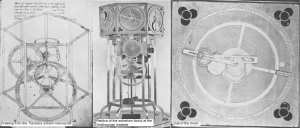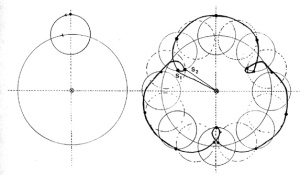by Jean-Roch Marion
When first confronted with the task of making a paper astrolabe as our first assignment, I became interested in the history of different types of medieval astronomical computers (clocks, astrolabes, equatoriums) in order to understand the origins of modern technology and modern thought. Contrary to contemporary electronics, the function of mechanical computers can be perceived by our senses and allow us to understand complicated processes with a simple physical action. Just like clocks and watches, the astrolabes were instruments created in order to compute what was perceived as natural cycles (the moon, the sun and the stars). They simulate the movement of the main celestial objects on a small scale map of the skies engraved on discs that you can manipulate to compute various data. Behind the front plate of the astrolabe, you can also find mathematical instruments that allow you to make complicated operations physically (trigonometry, conversion of units, etc.) Geared versions of astrolabes were also created in order to process more complex data. The earliest mechanical computer to be discovered is a calendar computer mechanism found in a shipwreck off the coast of Antikythera in Greece dating back to 80 B.C. (De Solla Price). In 1000 A.D., Muslim scholar al-Biruni describes a geared calendar that features similar mechanisms to the Antikythera and is found in various astrolabes dating from the Medieval Era. These instruments are at the origin of the common mechanical clock (Boudet) that rapidly become common integrations to towers of cathedrals of the 13th century.
As a first step to this third project of the semester, I wanted to reproduce an early mechanical computer in order to understand and its mechanism. Researching for detailed drawings and photographs of mechanical calendars and astrolabes lead me to discover Giovanni Dondi’s astrarium: a 14th century astronomical clock which displayed the position of the sun, the moon, five planets as well as the date and time on various dials. On display at the Castello Visconteo at Pavia, the astrarium was a complicated simulacrum of the geocentric universe following the Ptolemaic theory of motion of the planets. It was apparently marvelled upon by Leonardo Da Vinci, who sketched dials of the astrarium in his notebooks (Bedini et Maddison). Dondi also produced a manuscript that describes his masterpiece in detail entitled Tractatus astrarii. Since the original machine disappeared 150 years after its creation, this manuscript allowed replicas of the astronomical clock to be made. A model of the astrarium is on display at the Smithsonian Institute.
Using the Tractatus astrarii manuscript as well as various photographs of the existing replica of the astrarium, I reproduced the mechanism of its moon dial using thick chipboard and wooden dials. This mechanism simulates an epicyclical movement of the moon’s orbit: a eccentric elliptical rotation, as well as a circular oscillation. The complexity of the mechanism is hard to understand, as it integrates both sliding rules and rotating gears. Just like Leonardo in his time, I wanted to draw the movement of to the moon dial in order to understand it. Based on Leonardo’s drawings of the transmission rods found in his Codex Madrid I, I installed a drawing arm to the moon dial in order to trace its movement on paper. I discovered that the machine that I fabricated produced an elaborate oscillating shape with 14 indents that harmonizes every 5th rotation of the dial.
SOURCES
Bedini, Selvio A. and Francis R. Maddison. “Mechanical Universe: The Astrarium of Giovanni De Dondi.” Transactions of the American Philosophical Society (1996): 1-69.
Boudet, Jean-Patrice. “L’apparition des horloges mécaniques en Occident.” Revue Historique (1998): 145-154.
De Solla Price, Derek. “Automata and the Origins of Mechanism and Mechanistic Philosophy.” Source: Technology and Culture (1964): 9-23.
—. “Gears From The Greeks. The Antikythera Mechanism: A Calendar Computer from ca. 80 B.C.” Transactions of the American Philosophical Society 64.7 (1974): 1-70.
Leonardo’s Machines: Secrets and Inventions in the Da Vinci Codices, Firenze: Giunti, 2005
Sawday, Jonathan, Engines of the Imagination: Renaissance Culture and the Rise of the Machine, New York: Routledge, 2007
Lefevre, Wolfgang, ed., Picturing Machines 1400-1700, Cambridge, MA: The MIT Press, 2004.

